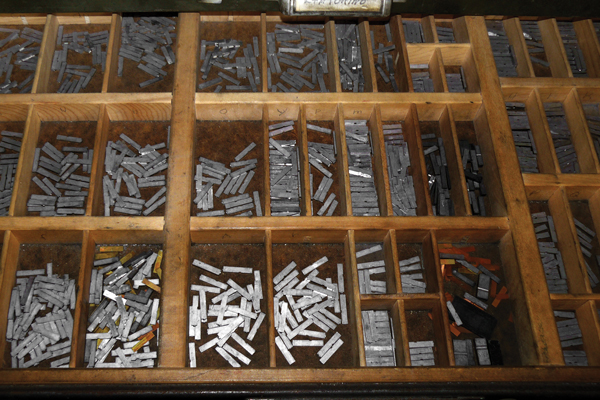How it All Started
The printing industry has evolved over many centuries, although for hundreds of years the printing process hardly changed. During the past fifty years, however, its acceleration has been phenomenal.
Originally, the complete image of a page was carved onto a piece of wood (fig. 1.1). This is still done in some parts of the world today. The remaining surface area—the letters—were inked and the cutout areas were not. When a sheet of paper (or parchment, or vellum) was pressed down onto the wood block and then peeled away carefully, the ink transferred onto the paper and an image was produced. Two tricky things regarding this method were: 1) what happened if there was a typo (typographical error), and 2) typos were more likely to occur because the page had to be carved as a reversed image of what was actually wanted, which is much harder to create accurately.
The invention of movable type on metal blocks was therefore a huge leap forward. Typos could be fixed quickly and easily and, once the job was finished, it could all be taken apart and used again for the next job. As well as type characters, decorative elements could be created (fig. 1.2).
Movable type was first developed in China in 1041 using clay characters. In 1440 Johannes Gutenberg produced the first movable metal type press in Europe, culminating in the production of the famous Gutenberg Bible in 1455.
Illustrations were combined with type for the first time when Albrecht Pfister printed Edelstein, which featured a number of woodcuts, in 1461. Fifteen years later, in 1476, William Caxton started printing in England—using typefaces that were intended to look like monks’ handwriting—and by the end of that century printing was taking place in 250 European cities. However, early in the seventeenth century the potential power of the printed word brought strong opposition from both Parliament and the Church. In 1637 an act was passed, limiting by decree the number of printers in England. Then, in 1644, the Licensing Act required all printed material to be approved by an official censor. With penalties that included fines, imprisonment, confiscation of equipment, and even death, this attempt to preserve the existing power structure was successful. As a result, by the end of the century there were only twenty master printers in England, eighteen in London. Given this kind of obstacle-ridden start, it is amazing that printing survived. No wonder “freedom of speech” and “freedom of the press” are taken so seriously today.
1.1 Printing blocks such as these, in which an entire page is carved into a single piece of wood, are still used in Nepal, Bhutan, and Tibet.

1.2 The use of movable type, where individual letters were created as separate, reusable metal blocks, meant that printing was suddenly easier, more accurate, and much faster than before.

